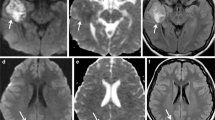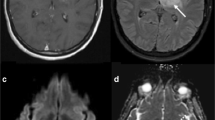Abstract
Pediatric brain tumors differ from those in adults by location, phenotype and genotype. In addition, they show dissimilar imaging characteristics before and after treatment. While adult brain tumor treatment effects are primarily assessed on MRI by measuring the contrast-enhancing components in addition to abnormalities on T2-weighted and fluid-attenuated inversion recovery images, these methods cannot be simply extrapolated to pediatric central nervous system tumors. A number of researchers have attempted to solve the problem of tumor assessment during treatment in pediatric neuro-oncology; specifically, the Response Assessment in Pediatric Neuro-Oncology (RAPNO) working group was recently established to deal with the distinct challenges in evaluating treatment-related changes on imaging, but no established criteria are available. In this article we review the current methods to evaluate brain tumor therapy and the numerous challenges that remain. In part 1, we examine the role of T2-weighted imaging and fluid-attenuated inversion recovery sequences, contrast enhancement, volumetrics and diffusion imaging techniques. We pay particular attention to several specific pediatric brain tumors, such as optic pathway glioma, diffuse midline glioma and medulloblastoma. Finally, we review the best means to assess leptomeningeal seeding.





Similar content being viewed by others
References
Warren KE, Poussaint TY, Vezina G et al (2013) Challenges with defining response to antitumor agents in pediatric neuro-oncology: a report from the Response Assessment in Pediatric Neuro-Oncology (RAPNO) working group. Pediatr Blood Cancer 60:1397–1401
Louis DN, Perry A, Reifenberger G et al (2016) The 2016 World Health Organization classification of tumors of the central nervous system: a summary. Acta Neuropathol 131:803–820
Chhabda S, Carney O, D’Arco F et al (2016) The 2016 World Health Organization classification of tumours of the central nervous system: what the paediatric neuroradiologist needs to know. Quant Imaging Med Surg 6:486–489
Wen PY, Macdonald DR, Reardon DA et al (2010) Updated response assessment criteria for high-grade gliomas: response assessment in neuro-oncology working group. J Clin Oncol 28:1963–1972
Wen PY, Chang SM, Van den Bent MJ et al (2017) Response assessment in neuro-oncology clinical trials. J Clin Oncol 35:2439–2449
Gaudino S, Quaglio F, Schiarelli C et al (2012) Spontaneous modifications of contrast enhancement in childhood non-cerebellar pilocytic astrocytomas. Neuroradiology 54:989–995
Gnekow AK, Kortmann RD, Pietsch T et al (2004) Low grade chiasmatic-hypothalamic glioma-carboplatin and vincristin chemotherapy effectively defers radiotherapy within a comprehensive treatment strategy — report from the multicenter treatment study for children and adolescents with a low grade glioma — HIT-LGG 1996 — of the Society of Pediatric Oncology and Hematology (GPOH). Klin Padiatr 216:331–342
Warren KE, Patronas N, Aikin AA et al (2001) Comparison of one-, two-, and three-dimensional measurements of childhood brain tumors. J Natl Cancer Inst 93:1401–1405
Kilday J-P, Branson H, Rockel C et al (2015) Tumor volumetric measurements in surgically inaccessible pediatric low-grade glioma. J Pediatr Hematol Oncol 37:e31–e36
Rees J, Watt H, Jäger HR et al (2009) Volumes and growth rates of untreated adult low-grade gliomas indicate risk of early malignant transformation. Eur J Radiol 72:54–64
Connor SEJ, Gunny R, Hampton T et al (2004) Magnetic resonance image registration and subtraction in the assessment of minor changes in low grade glioma volume. Eur Radiol 14:2061–2066
D’Arco F, O’Hare P, Dashti F et al (2018) Volumetric assessment of tumor size changes in pediatric low-grade gliomas: feasibility and comparison with linear measurements. Neuroradiology 60:427–436
Dombi E, Ardern-Holmes SL, Babovic-Vuksanovic D et al (2013) Recommendations for imaging tumor response in neurofibromatosis clinical trials. Neurology 81:S33–S40
Jaspan T, Morgan PS, Warmuth-Metz M et al (2016) Response assessment in pediatric neuro-oncology: implementation and expansion of the RANO criteria in a randomized phase II trial of pediatric patients with newly diagnosed high-grade gliomas. AJNR Am J Neuroradiol 37:1581–1587
Weber M-A, Giesel FL, Stieltjes B (2008) MRI for identification of progression in brain tumors: from morphology to function. Expert Rev Neurother 8:1507–1525
Maier SE, Sun Y, Mulkern RV (2010) Diffusion imaging of brain tumors. NMR Biomed 23:849–864
Asao C, Korogi Y, Kitajima M et al (2005) Diffusion-weighted imaging of radiation-induced brain injury for differentiation from tumor recurrence. AJNR Am J Neuroradiol 26:1455–1460
Löbel U, Sedlacik J, Reddick WE et al (2011) Quantitative diffusion-weighted and dynamic susceptibility-weighted contrast-enhanced perfusion MR imaging analysis of T2 hypointense lesion components in pediatric diffuse intrinsic pontine glioma. AJNR Am J Neuroradiol 32:315–322
Huang WY, Wen JB, Wu G et al (2016) Diffusion-weighted imaging for predicting and monitoring primary central nervous system lymphoma treatment response. AJNR Am J Neuroradiol. https://doi.org/10.3174/ajnr.A4867
Steen RG (1992) Edema and tumor perfusion: characterization by quantitative 1H MR imaging. AJR Am J Roentgenol 158:259–264
Mardor Y, Roth Y, Lidar Z et al (2001) Monitoring response to convection-enhanced taxol delivery in brain tumor patients using diffusion-weighted magnetic resonance imaging. Cancer Res 61:4971–4973
Mardor Y, Pfeffer R, Spiegelmann R et al (2003) Early detection of response to radiation therapy in patients with brain malignancies using conventional and high b-value diffusion-weighted magnetic resonance imaging. J Clin Oncol 21:1094–1100
Sinha S, Bastin ME, Whittle IR et al (2002) Diffusion tensor MR imaging of high-grade cerebral gliomas. AJNR Am J Neuroradiol 23:520–527
Ge M, Li S, Wang L et al (2015) The role of diffusion tensor tractography in the surgical treatment of pediatric optic chiasmatic gliomas. J Neurooncol 122:357–366
Fink JR, Muzi M, Peck M et al (2015) Multimodality brain tumor imaging: MR imaging, PET, and PET MRI imaging. J Nucl Med 56:1554-61. https://doi.org/10.2967/jnumed.113.131516
Castellano A, Bello L, Michelozzi C et al (2012) Role of diffusion tensor magnetic resonance tractography in predicting the extent of resection in glioma surgery. Neuro Oncol 14:192–202
Jellison BJ, Field AS, Medow J et al (2004) Diffusion tensor imaging of cerebral white matter: a pictorial review of physics, fiber tract anatomy, and tumor imaging patterns. AJNR Am J Neuroradiol 25:356–369
van der Heide UA, Houweling AC, Groenendaal G et al (2012) Functional MRI for radiotherapy dose painting. Magn Reson Imaging 30:1216–1223
Hygino da Cruz LC, Rodriguez I, Domingues RC et al (2011) Pseudoprogression and pseudoresponse: imaging challenges in the assessment of posttreatment glioma. AJNR Am J Neuroradiol 32:1978–1985
Chang JH, Kim C-Y, Choi BS et al (2014) Pseudoprogression and pseudoresponse in the management of high-grade glioma: optimal decision timing according to the response assessment of the neuro-oncology working group. J Korean Neurosurg Soc 55:5–11
Brandsma D, van den Bent MJ (2009) Pseudoprogression and pseudoresponse in the treatment of gliomas. Curr Opin Neurol 22:633–638
Beres SJ, Avery RA (2017) Optic pathway gliomas secondary to neurofibromatosis type 1. Semin Pediatr Neurol 24:92–99
Kornreich L, Blaser S, Schwarz M et al (2001) Optic pathway glioma: correlation of imaging findings with the presence of neurofibromatosis. AJNR Am J Neuroradiol 22:1963–1969
Chateil JF, Soussotte C, Pédespan JM et al (2001) MRI and clinical differences between optic pathway tumours in children with and without neurofibromatosis. Br J Radiol 74:24–31
Zuccoli G, Ferrozzi F, Sigorini M et al (2000) Early spontaneous regression of a hypothalamic/chiasmatic mass in neurofibromatosis type 1: MR findings. Eur Radiol 10:1076–1078
Avery RA, Ferner RE, Listernick R et al (2012) Visual acuity in children with low grade gliomas of the visual pathway: implications for patient care and clinical research. J Neuro-Oncol 110:1–7
Dodgshun AJ, Elder JE, Hansford JR et al (2015) Long-term visual outcome after chemotherapy for optic pathway glioma in children: site and age are strongly predictive. Cancer 121:4190–4196
de Blank PMK, Fisher MJ, Liu GT et al (2017) Optic pathway gliomas in neurofibromatosis type 1: an update: surveillance, treatment indications, and biomarkers of vision. J Neuroophthalmol 37:S23–S32
Taylor T, Jaspan T, Milano G et al (2008) Radiological classification of optic pathway gliomas: experience of a modified functional classification system. Br J Radiol 81:761–766
van den Bent MJ, Wefel JS, Schiff D et al (2011) Response assessment in neuro-oncology (a report of the RANO group): assessment of outcome in trials of diffuse low-grade gliomas. Lancet Oncol 12:583–593
Hales PW, Smith V, Dhanoa-Hayre D et al (2018) Delineation of the visual pathway in paediatric optic pathway glioma patients using probabilistic tractography, and correlations with visual acuity. Neuroimage Clin 17:541–548
Svolos P, Reddick WE, Edwards A et al (2017) Measurable supratentorial white matter volume changes in patients with diffuse intrinsic pontine glioma treated with an anti-vascular endothelial growth factor agent, steroids, and radiation. AJNR Am J Neuroradiol 38:1235–1241
Warren KE (2012) Diffuse intrinsic pontine glioma: poised for progress. Front Oncol 2:205
Burzynski SR, Janicki TJ, Burzynski GS et al (2014) The response and survival of children with recurrent diffuse intrinsic pontine glioma based on phase II study of antineoplastons A10 and AS2-1 in patients with brainstem glioma. Childs Nerv Syst 30:2051–2061
Löbel U, Hwang S, Edwards A et al (2016) Discrepant longitudinal volumetric and metabolic evolution of diffuse intrinsic pontine gliomas during treatment: implications for current response assessment strategies. Neuroradiology 58:1027–1034
Perreault S, Ramaswamy V, Achrol AS et al (2014) MRI surrogates for molecular subgroups of medulloblastoma. AJNR Am J Neuroradiol 35:1263–1269
Packer RJ, Gajjar A, Vezina G et al (2006) Phase III study of craniospinal radiation therapy followed by adjuvant chemotherapy for newly diagnosed average-risk medulloblastoma. J Clin Oncol 24:4202–4208
Warren KE, Vezina G, Poussaint TY et al (2018) Response assessment in medulloblastoma and leptomeningeal seeding tumors: recommendations from the response assessment in pediatric neuro-oncology committee. Neuro Oncol 20:13–23
Chamberlain M, Junck L, Brandsma D et al (2017) Leptomeningeal metastases: a RANO proposal for response criteria. Neuro Oncol 19:484–492
Author information
Authors and Affiliations
Corresponding author
Ethics declarations
Conflicts of interest
None
Rights and permissions
About this article
Cite this article
D’Arco, F., Culleton, S., De Cocker, L.J.L. et al. Current concepts in radiologic assessment of pediatric brain tumors during treatment, part 1. Pediatr Radiol 48, 1833–1843 (2018). https://doi.org/10.1007/s00247-018-4194-9
Received:
Revised:
Accepted:
Published:
Issue Date:
DOI: https://doi.org/10.1007/s00247-018-4194-9




